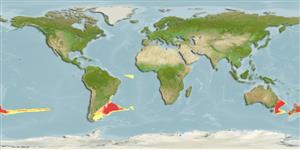>
Aulopiformes (Grinners) >
Scopelarchidae (Pearleyes)
Etymology: Scopelarchoides: Greek, skopelos = a lantern fish + Greek, archos = anus + Greek, oides = similar (Ref. 45335).
Environment: milieu / climate zone / depth range / distribution range
Ecologia
marinhas batipelágico; intervalo de profundidade 0 - 2000 m (Ref. 58018). Deep-water
Southwest Atlantic, Argentine basin and Southwest Pacific, off southern Tasmania.
Tamanho / Peso / Idade
Maturity: Lm ? range ? - ? cm
Max length : 19.0 cm SL macho/indeterminado; (Ref. 75653)
Descrição suscinta
Chaves de identificação | Morfologia | Morfometria
Raios dorsais (total) : 8 - 9; Vértebras: 55. This species is distinguished from all other species of the family by the following characters: pectoral fin distinctly shorter than the pelvic fin; pelvic-fin origin anterior to a vertical through the first dorsal-fin origin; lingual teeth found over the basihyal and the first basibranchial; lateral-line scales 58 or 59; pigment stripes along the lateral line (Ref. 75653).
Ciclo de vida ou comportamento de acasalamento
Maturities | Reprodução | Spawnings | Egg(s) | Fecundities | Larvas
Motomura, H., P.R. Last and G.K. Yearsley, 2007. Scopelarchoides kreffti (Actinopterygii: Aulopiformes: Scopelarchidae) from off Tasmania, Australia: first records from outside the South Atlantic Ocean. Species Diversity 12:9-15. (Ref. 75653)
Status na Lista Vermelha da UICN (Ref. 130435)
Ameaça para os humanos
Harmless
Uso pelos humanos
Ferramentas
Relatórios especiais
Baixar XML
Fontes da internet
Estimates based on models
Preferred temperature (Ref.
123201): 6.8 - 12.5, mean 8.4 °C (based on 119 cells).
Índice de diversidade filogenética (Ref.
82804): PD
50 = 0.5313 [Uniqueness, from 0.5 = low to 2.0 = high].
Bayesian length-weight: a=0.01000 (0.00244 - 0.04107), b=3.04 (2.81 - 3.27), in cm total length, based on all LWR estimates for this body shape (Ref.
93245).
Nível Trófico (Ref.
69278): 4.4 ±0.8 se; based on size and trophs of closest relatives
Fishing Vulnerability (Ref.
59153): Low vulnerability (13 of 100).
